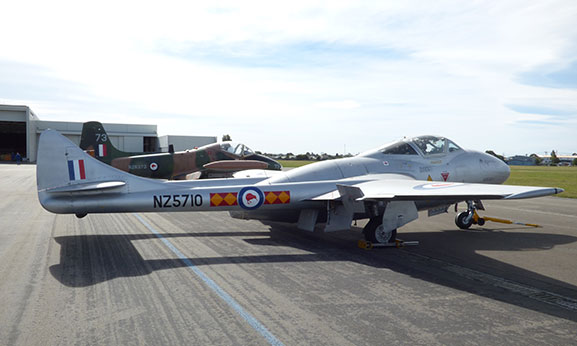De Havilland D.H.115 Vampire T.Mk.II
Specifications
RNZAF serial no. NZ5710
Ex-RAF serial no. XH317
Manufacturer’s no. 15691
On display in the Reserve Collection
Can be viewed on the Daily Tour
Distinctive for its twin-boom tail and combined wood and metal construction, the de Havilland Vampire was the first jet aircraft to be flown operationally by the RNZAF.
Originally developed as an experimental aircraft during World War Two, the Vampire went into production in 1944 and entered service as a combat aircraft with the Royal Air Force (RAF) in 1946.
The RNZAF operated more Vampires than any other aircraft type after World War Two; 58 in total, between 1951 and 1972. 18 brand-new FB.52 models arrived first in 1951-52 to equip No. 14 Squadron at Ohakea, soon followed by six T.55 dual trainers, while eight second-hand FB.5s were purchased from the RAF in 1953 to replace those lost in accidents. With the decision that Territorial Air Force pilots would undergo jet conversion training, another 21 ex-RAF FB.5s and five brand-new T.11s were acquired in 1955-56. Operationally, the Vampires served in the fighter and ground attack role with both 14 and 75 Squadrons, until the arrival of the Canberras between 1959-1961 reduced them to training only.

NZ5710
Acquired brand-new in 1956, Vampire T.11 NZ5710 went into service in June 1956 with the Jet Conversion Unit at Ohakea. It was retired in December 1972 and placed into storage at Woodbourne, where it was converted to an instructional airframe before being transferred to the Air Force Museum of New Zealand’s collection in 1984.



